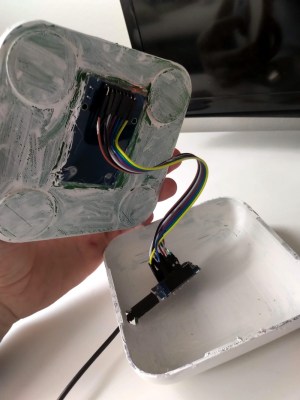Besides a few stalwart holdouts, most of us have have switched over listening to music in digital form, often via an online stream. As long as no data caps stand in your way, it’s a quick and easy way to listen to your favorite artists or discover new ones. But there’s something visceral about act of loading a piece of physical media into a player that can’t be replicated by just clicking or tapping on a screen.
 Which is why [InfiniteVideo] put together this RFID playlist launcher peripheral. There’s an important distinction to be made here, as this device isn’t actually playing or even storing audio. A nearby Raspberry running Volumio handles the actual playback. This device is just an RFID reader with some clever tokens that the listener can use to select their favorite artists and albums with physical tokens. It’s certainly not a new concept, but we think the nuances of this particular build warrant a closer look.
Which is why [InfiniteVideo] put together this RFID playlist launcher peripheral. There’s an important distinction to be made here, as this device isn’t actually playing or even storing audio. A nearby Raspberry running Volumio handles the actual playback. This device is just an RFID reader with some clever tokens that the listener can use to select their favorite artists and albums with physical tokens. It’s certainly not a new concept, but we think the nuances of this particular build warrant a closer look.
The “player” consists of a ESP8266 with a MFRC522 RFID reader wired directly to the GPIO pins. The pair are housed in a rather large 3D printed enclosure, which at first might seem a bit excessive. But it turns out that [InfiniteVideo] is actually trying to replicate a crowd sourced project called Qleek which is based around a similarly chunky reader.
Likewise, the hexagon tiles are also lifted from the Qleek concept. But rather than being made out of wood as in the original, [InfiniteVideo] is printing those as well. Halfway during the process, the print is paused and an RFID sticker is placed in the middle of the hexagon. Once resumed, the RFID tag becomes permanently embedded in the tile with no visible seams to reveal how the trick was pulled off. With the addition of a suitable label, each printed hexagon gets associated with the desired album or artist in software.
This project is notable for its convenience and visual flair, but using RFID tags for media identification can also be a practical choice. It can be used as an assistive technology, or as a way for young children to easily interact with devices.
















Okay, howabout it’s like a tool or dead album, and they’re like marbles, and go down a marble run, and like get read then held up on a jet of air, where like a laser shines through them, and they’re like holographic and it projects like trippy crap on the ceiling man.
Simple idea but I like the aesthetic, he should make them magnetic so he can put them on the wall, they’ed make a nice display.
OMG, no! The magnetic field would sublimate the natural highs of the RFID tag, and if you store them vertically they will warp and introduce wow into the mix!
Well you have to use audiophile quality gold magnets and slate walls of course.
If you want to remember “The Lion Sleeps Tonight” you will need a Token token.
…and if there’s ever a jukebox version of this player, one will need some form of tokens to play it ;) especially if the jukebox winds up in a casino or game arcade (I have to say, I miss arcades, despite the unbelievable noise (I get sensory overload unbelievably easy) and paltry prize offerings (somewhat out of necessity… I understand, I just don’t like it!)…).
…not that such placement woumd be terrifically *practical*, mind you… but if you’re the stuffy, overly-starched suit type for whom practicality actually matters, you’re on the wrong website anyways. We don’t *do* that here ;)
Django Reinhardt! Amazing guitar player. Yes, you got my attention.
Nice project! I want to do the same for my audio library with the tiles being discs sliding down a chute to the reader. You would be able to see your playlist advancing to the next track/album.
I like the marble run idea too. Fun way to shuffle a playlist.
Way back in 2014, I set up a dozen “self-guided tour audio playback” devices that ran on a Parallax Propeller with a VMusic2 MP3 module and a Parallax RFID reader. At various locations along the tour, 2″ round tags were glued into place and covered with a placard to mark the location of a “Tour Tag”. Each tag ID linked to an audio track that would explain that location on the tour. The second version used WAV files so I could avoid the VMusic module and shrunk the size considerably. They both worked great until they were replaced with a phone app about 3 years ago.
*”cue up”
You’re welcome.
Possibly, though ambiguous as having them ready to go in a play list queue makes sense two*.
* ;-)
Except they are physical objects that are being lined up. You just didn’t understand the joke.